Kaixun Jiang
LingoLoop Attack: Trapping MLLMs via Linguistic Context and State Entrapment into Endless Loops
Jun 17, 2025Abstract:Multimodal Large Language Models (MLLMs) have shown great promise but require substantial computational resources during inference. Attackers can exploit this by inducing excessive output, leading to resource exhaustion and service degradation. Prior energy-latency attacks aim to increase generation time by broadly shifting the output token distribution away from the EOS token, but they neglect the influence of token-level Part-of-Speech (POS) characteristics on EOS and sentence-level structural patterns on output counts, limiting their efficacy. To address this, we propose LingoLoop, an attack designed to induce MLLMs to generate excessively verbose and repetitive sequences. First, we find that the POS tag of a token strongly affects the likelihood of generating an EOS token. Based on this insight, we propose a POS-Aware Delay Mechanism to postpone EOS token generation by adjusting attention weights guided by POS information. Second, we identify that constraining output diversity to induce repetitive loops is effective for sustained generation. We introduce a Generative Path Pruning Mechanism that limits the magnitude of hidden states, encouraging the model to produce persistent loops. Extensive experiments demonstrate LingoLoop can increase generated tokens by up to 30 times and energy consumption by a comparable factor on models like Qwen2.5-VL-3B, consistently driving MLLMs towards their maximum generation limits. These findings expose significant MLLMs' vulnerabilities, posing challenges for their reliable deployment. The code will be released publicly following the paper's acceptance.
VideoPure: Diffusion-based Adversarial Purification for Video Recognition
Jan 25, 2025



Abstract:Recent work indicates that video recognition models are vulnerable to adversarial examples, posing a serious security risk to downstream applications. However, current research has primarily focused on adversarial attacks, with limited work exploring defense mechanisms. Furthermore, due to the spatial-temporal complexity of videos, existing video defense methods face issues of high cost, overfitting, and limited defense performance. Recently, diffusion-based adversarial purification methods have achieved robust defense performance in the image domain. However, due to the additional temporal dimension in videos, directly applying these diffusion-based adversarial purification methods to the video domain suffers performance and efficiency degradation. To achieve an efficient and effective video adversarial defense method, we propose the first diffusion-based video purification framework to improve video recognition models' adversarial robustness: VideoPure. Given an adversarial example, we first employ temporal DDIM inversion to transform the input distribution into a temporally consistent and trajectory-defined distribution, covering adversarial noise while preserving more video structure. Then, during DDIM denoising, we leverage intermediate results at each denoising step and conduct guided spatial-temporal optimization, removing adversarial noise while maintaining temporal consistency. Finally, we input the list of optimized intermediate results into the video recognition model for multi-step voting to obtain the predicted class. We investigate the defense performance of our method against black-box, gray-box, and adaptive attacks on benchmark datasets and models. Compared with other adversarial purification methods, our method overall demonstrates better defense performance against different attacks. Our code is available at https://github.com/deep-kaixun/VideoPure.
DeTrack: In-model Latent Denoising Learning for Visual Object Tracking
Jan 05, 2025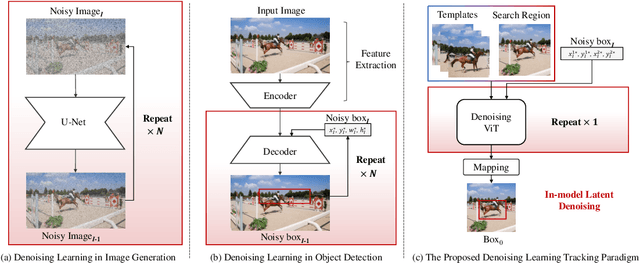

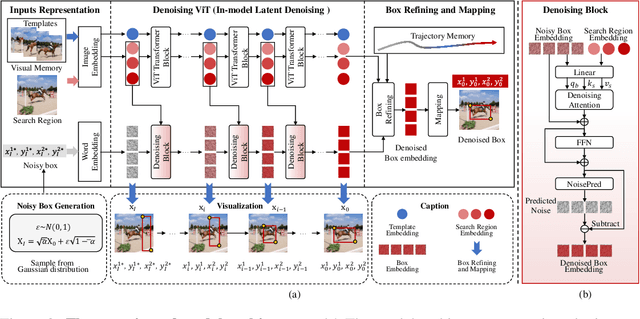
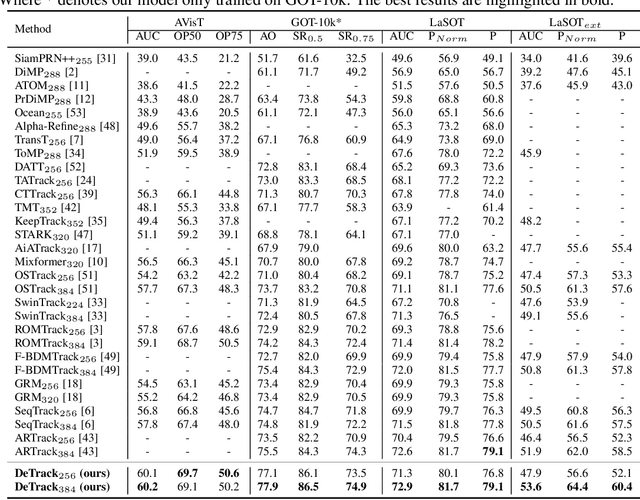
Abstract:Previous visual object tracking methods employ image-feature regression models or coordinate autoregression models for bounding box prediction. Image-feature regression methods heavily depend on matching results and do not utilize positional prior, while the autoregressive approach can only be trained using bounding boxes available in the training set, potentially resulting in suboptimal performance during testing with unseen data. Inspired by the diffusion model, denoising learning enhances the model's robustness to unseen data. Therefore, We introduce noise to bounding boxes, generating noisy boxes for training, thus enhancing model robustness on testing data. We propose a new paradigm to formulate the visual object tracking problem as a denoising learning process. However, tracking algorithms are usually asked to run in real-time, directly applying the diffusion model to object tracking would severely impair tracking speed. Therefore, we decompose the denoising learning process into every denoising block within a model, not by running the model multiple times, and thus we summarize the proposed paradigm as an in-model latent denoising learning process. Specifically, we propose a denoising Vision Transformer (ViT), which is composed of multiple denoising blocks. In the denoising block, template and search embeddings are projected into every denoising block as conditions. A denoising block is responsible for removing the noise in a predicted bounding box, and multiple stacked denoising blocks cooperate to accomplish the whole denoising process. Subsequently, we utilize image features and trajectory information to refine the denoised bounding box. Besides, we also utilize trajectory memory and visual memory to improve tracking stability. Experimental results validate the effectiveness of our approach, achieving competitive performance on several challenging datasets.
X-Prompt: Multi-modal Visual Prompt for Video Object Segmentation
Sep 28, 2024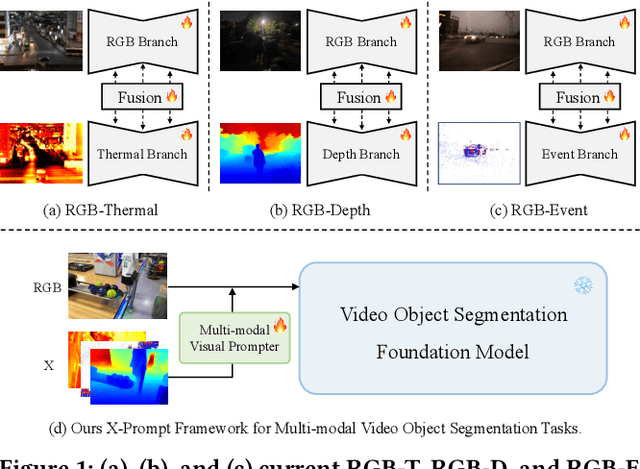
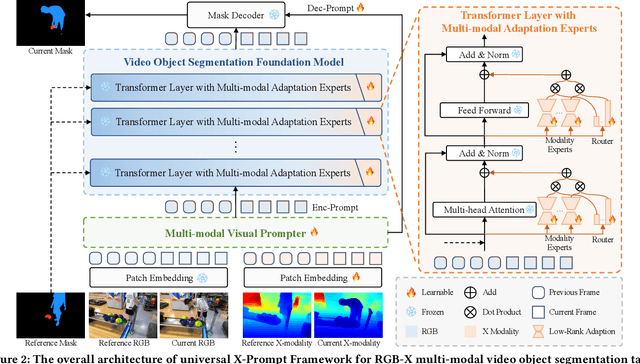
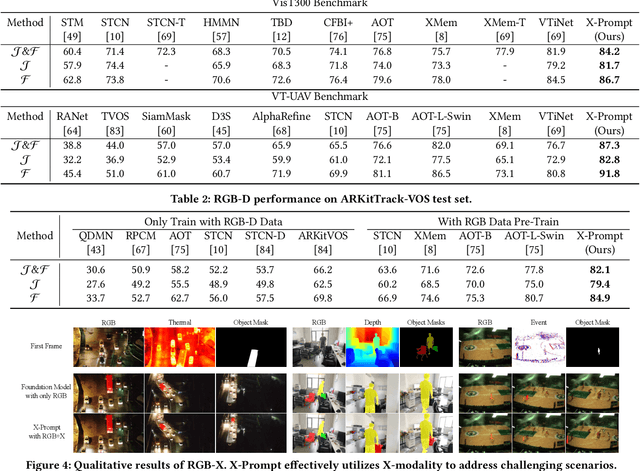

Abstract:Multi-modal Video Object Segmentation (VOS), including RGB-Thermal, RGB-Depth, and RGB-Event, has garnered attention due to its capability to address challenging scenarios where traditional VOS methods struggle, such as extreme illumination, rapid motion, and background distraction. Existing approaches often involve designing specific additional branches and performing full-parameter fine-tuning for fusion in each task. However, this paradigm not only duplicates research efforts and hardware costs but also risks model collapse with the limited multi-modal annotated data. In this paper, we propose a universal framework named X-Prompt for all multi-modal video object segmentation tasks, designated as RGB+X. The X-Prompt framework first pre-trains a video object segmentation foundation model using RGB data, and then utilize the additional modality of the prompt to adapt it to downstream multi-modal tasks with limited data. Within the X-Prompt framework, we introduce the Multi-modal Visual Prompter (MVP), which allows prompting foundation model with the various modalities to segment objects precisely. We further propose the Multi-modal Adaptation Experts (MAEs) to adapt the foundation model with pluggable modality-specific knowledge without compromising the generalization capacity. To evaluate the effectiveness of the X-Prompt framework, we conduct extensive experiments on 3 tasks across 4 benchmarks. The proposed universal X-Prompt framework consistently outperforms the full fine-tuning paradigm and achieves state-of-the-art performance. Code: https://github.com/PinxueGuo/X-Prompt.git
General Compression Framework for Efficient Transformer Object Tracking
Sep 26, 2024



Abstract:Transformer-based trackers have established a dominant role in the field of visual object tracking. While these trackers exhibit promising performance, their deployment on resource-constrained devices remains challenging due to inefficiencies. To improve the inference efficiency and reduce the computation cost, prior approaches have aimed to either design lightweight trackers or distill knowledge from larger teacher models into more compact student trackers. However, these solutions often sacrifice accuracy for speed. Thus, we propose a general model compression framework for efficient transformer object tracking, named CompressTracker, to reduce the size of a pre-trained tracking model into a lightweight tracker with minimal performance degradation. Our approach features a novel stage division strategy that segments the transformer layers of the teacher model into distinct stages, enabling the student model to emulate each corresponding teacher stage more effectively. Additionally, we also design a unique replacement training technique that involves randomly substituting specific stages in the student model with those from the teacher model, as opposed to training the student model in isolation. Replacement training enhances the student model's ability to replicate the teacher model's behavior. To further forcing student model to emulate teacher model, we incorporate prediction guidance and stage-wise feature mimicking to provide additional supervision during the teacher model's compression process. Our framework CompressTracker is structurally agnostic, making it compatible with any transformer architecture. We conduct a series of experiment to verify the effectiveness and generalizability of CompressTracker. Our CompressTracker-4 with 4 transformer layers, which is compressed from OSTrack, retains about 96% performance on LaSOT (66.1% AUC) while achieves 2.17x speed up.
TagOOD: A Novel Approach to Out-of-Distribution Detection via Vision-Language Representations and Class Center Learning
Aug 28, 2024
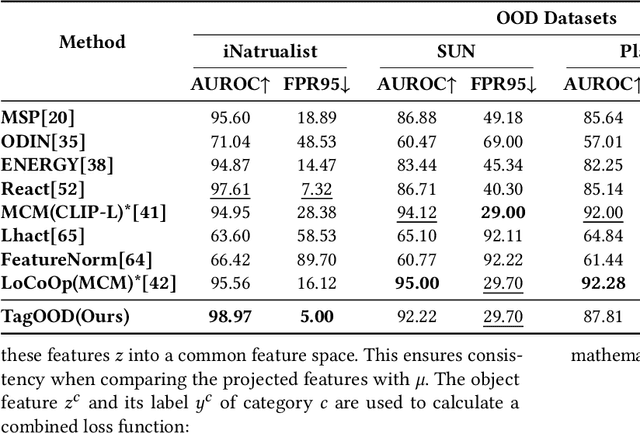


Abstract:Multimodal fusion, leveraging data like vision and language, is rapidly gaining traction. This enriched data representation improves performance across various tasks. Existing methods for out-of-distribution (OOD) detection, a critical area where AI models encounter unseen data in real-world scenarios, rely heavily on whole-image features. These image-level features can include irrelevant information that hinders the detection of OOD samples, ultimately limiting overall performance. In this paper, we propose \textbf{TagOOD}, a novel approach for OOD detection that leverages vision-language representations to achieve label-free object feature decoupling from whole images. This decomposition enables a more focused analysis of object semantics, enhancing OOD detection performance. Subsequently, TagOOD trains a lightweight network on the extracted object features to learn representative class centers. These centers capture the central tendencies of IND object classes, minimizing the influence of irrelevant image features during OOD detection. Finally, our approach efficiently detects OOD samples by calculating distance-based metrics as OOD scores between learned centers and test samples. We conduct extensive experiments to evaluate TagOOD on several benchmark datasets and demonstrate its superior performance compared to existing OOD detection methods. This work presents a novel perspective for further exploration of multimodal information utilization in OOD detection, with potential applications across various tasks.
PG-Attack: A Precision-Guided Adversarial Attack Framework Against Vision Foundation Models for Autonomous Driving
Jul 18, 2024Abstract:Vision foundation models are increasingly employed in autonomous driving systems due to their advanced capabilities. However, these models are susceptible to adversarial attacks, posing significant risks to the reliability and safety of autonomous vehicles. Adversaries can exploit these vulnerabilities to manipulate the vehicle's perception of its surroundings, leading to erroneous decisions and potentially catastrophic consequences. To address this challenge, we propose a novel Precision-Guided Adversarial Attack (PG-Attack) framework that combines two techniques: Precision Mask Perturbation Attack (PMP-Attack) and Deceptive Text Patch Attack (DTP-Attack). PMP-Attack precisely targets the attack region to minimize the overall perturbation while maximizing its impact on the target object's representation in the model's feature space. DTP-Attack introduces deceptive text patches that disrupt the model's understanding of the scene, further enhancing the attack's effectiveness. Our experiments demonstrate that PG-Attack successfully deceives a variety of advanced multi-modal large models, including GPT-4V, Qwen-VL, and imp-V1. Additionally, we won First-Place in the CVPR 2024 Workshop Challenge: Black-box Adversarial Attacks on Vision Foundation Models and codes are available at https://github.com/fuhaha824/PG-Attack.
Improving Adversarial Transferability of Visual-Language Pre-training Models through Collaborative Multimodal Interaction
Mar 16, 2024Abstract:Despite the substantial advancements in Vision-Language Pre-training (VLP) models, their susceptibility to adversarial attacks poses a significant challenge. Existing work rarely studies the transferability of attacks on VLP models, resulting in a substantial performance gap from white-box attacks. We observe that prior work overlooks the interaction mechanisms between modalities, which plays a crucial role in understanding the intricacies of VLP models. In response, we propose a novel attack, called Collaborative Multimodal Interaction Attack (CMI-Attack), leveraging modality interaction through embedding guidance and interaction enhancement. Specifically, attacking text at the embedding level while preserving semantics, as well as utilizing interaction image gradients to enhance constraints on perturbations of texts and images. Significantly, in the image-text retrieval task on Flickr30K dataset, CMI-Attack raises the transfer success rates from ALBEF to TCL, $\text{CLIP}_{\text{ViT}}$ and $\text{CLIP}_{\text{CNN}}$ by 8.11%-16.75% over state-of-the-art methods. Moreover, CMI-Attack also demonstrates superior performance in cross-task generalization scenarios. Our work addresses the underexplored realm of transfer attacks on VLP models, shedding light on the importance of modality interaction for enhanced adversarial robustness.
OneTracker: Unifying Visual Object Tracking with Foundation Models and Efficient Tuning
Mar 14, 2024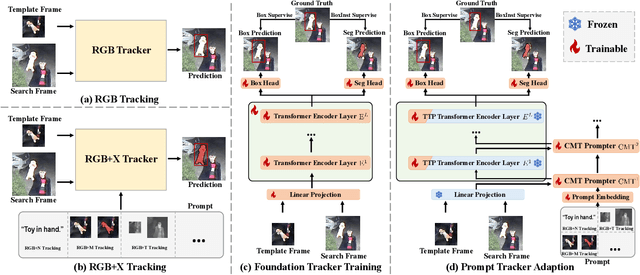
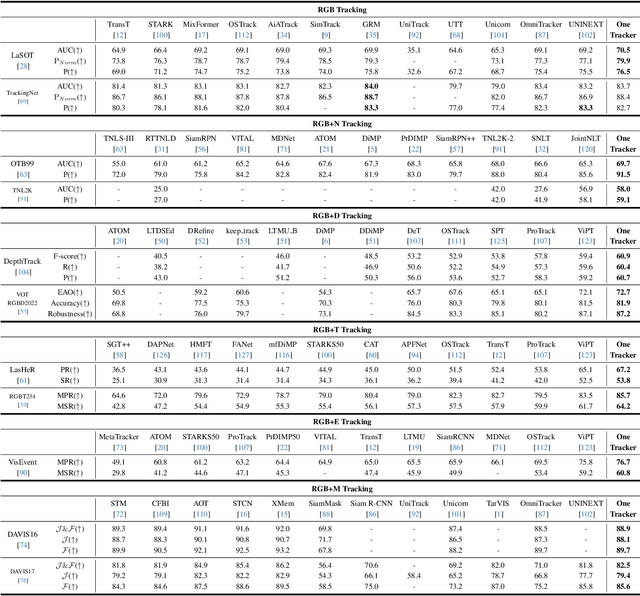
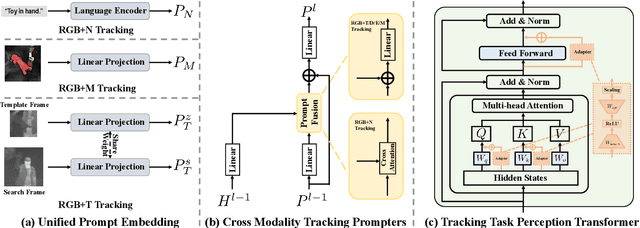

Abstract:Visual object tracking aims to localize the target object of each frame based on its initial appearance in the first frame. Depending on the input modility, tracking tasks can be divided into RGB tracking and RGB+X (e.g. RGB+N, and RGB+D) tracking. Despite the different input modalities, the core aspect of tracking is the temporal matching. Based on this common ground, we present a general framework to unify various tracking tasks, termed as OneTracker. OneTracker first performs a large-scale pre-training on a RGB tracker called Foundation Tracker. This pretraining phase equips the Foundation Tracker with a stable ability to estimate the location of the target object. Then we regard other modality information as prompt and build Prompt Tracker upon Foundation Tracker. Through freezing the Foundation Tracker and only adjusting some additional trainable parameters, Prompt Tracker inhibits the strong localization ability from Foundation Tracker and achieves parameter-efficient finetuning on downstream RGB+X tracking tasks. To evaluate the effectiveness of our general framework OneTracker, which is consisted of Foundation Tracker and Prompt Tracker, we conduct extensive experiments on 6 popular tracking tasks across 11 benchmarks and our OneTracker outperforms other models and achieves state-of-the-art performance.
Delving into Decision-based Black-box Attacks on Semantic Segmentation
Feb 02, 2024Abstract:Semantic segmentation is a fundamental visual task that finds extensive deployment in applications with security-sensitive considerations. Nonetheless, recent work illustrates the adversarial vulnerability of semantic segmentation models to white-box attacks. However, its adversarial robustness against black-box attacks has not been fully explored. In this paper, we present the first exploration of black-box decision-based attacks on semantic segmentation. First, we analyze the challenges that semantic segmentation brings to decision-based attacks through the case study. Then, to address these challenges, we first propose a decision-based attack on semantic segmentation, called Discrete Linear Attack (DLA). Based on random search and proxy index, we utilize the discrete linear noises for perturbation exploration and calibration to achieve efficient attack efficiency. We conduct adversarial robustness evaluation on 5 models from Cityscapes and ADE20K under 8 attacks. DLA shows its formidable power on Cityscapes by dramatically reducing PSPNet's mIoU from an impressive 77.83% to a mere 2.14% with just 50 queries.
 Add to Chrome
Add to Chrome Add to Firefox
Add to Firefox Add to Edge
Add to Edge